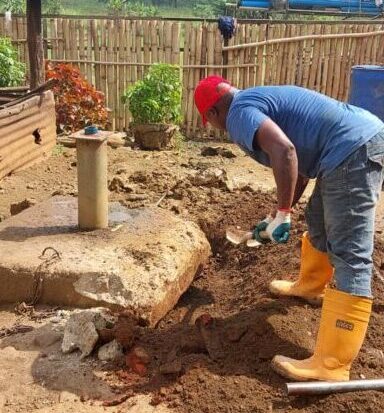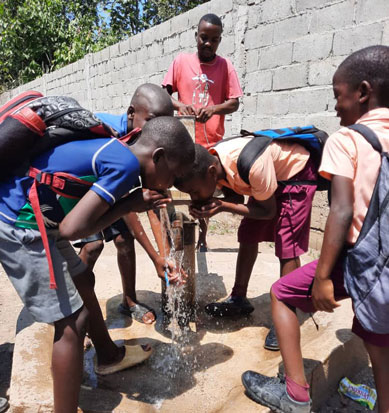We link all donations to specific projects so that when projects are completed, donors have access to detailed reporting including photos, GPS coordinates, community profiles and thank-you letters.
Search for a project by location, project type, project number, donor name, or enter “sponsor needed” if looking for a project without a sponsor yet.

We drill wells to a depth of at least 100 ft, and install a sanitary seal to stop contaminated ground water from leaking in. We also install hand-powered pumps to prevent the contamination that occurs when using a rope-and-bucket method. The new well is disinfected immediately after drilling, then again after the pump has been installed to ensure no contamination from the drilling process remains in the well.
Each well has an official Well Caretaker who the community has selected and we have trained and equipped. Learn more about our Strategy.

We rehabilitate dormant wells that are no longer providing water. This usually involves replacing the existing hand pump and the concrete pad surrounding it, along with a full disinfection. The well and pad are restored to a safe working condition. Lifewater replaces and rehabilitates wells that we originally drilled, and those drilled by other organizations who no longer provide support.

A hand-powered pump is comprised of several mechanical parts, and depending on the frequency of use, repairs will inevitably be necessary. Lifewater repairs pumps that we have installed, and those drilled by other organizations who no longer provide support.

One of the most important ways a community can become more sanitary and water safe is by having proper disposal of their sewage. We build community toilets and hand-washing stations at schools, churches, orphanages, medical clinics, and community centres. The type of washroom varies from single-stall pit latrines to six-stall pail-flush toilets with septic tanks. As a result, there is a wide range in construction costs.
As part of some of these projects, we also install large rainwater storage tanks to store water for sanitation purposes only. Local community members are responsible for ongoing maintenance and treating the water with chlorine to ensure it remains safe to use.

Safe water drawn from a new well or rehabilitated well will quickly become contaminated if the users do not engage in adequate health and hygiene practices. All Lifewater Canada projects include a workshop to help community members learn about the sources of dysentery, cholera, and other diarrheal diseases, disease transmission and how to reduce it, and how to care for their water and environment. We also offer stand-alone training in communities where there isn’t an ongoing Lifewater project.

We distribute washable/reusable sanitary pads at health and hygiene workshops, ensuring menstrual periods do not stop girls from attending school and continuing their education. This program began with the STADA team in Kenya, but in 2025 we successfully incorporated Dignity Kits in Liberia and Nigeria as well.
Read more about our Dignity Kit program and the fight against "period poverty".
The ripple effect of safe water
The United Nations put forward 17 Sustainable Development Goals (SDG’s) that need urgent global attention. These goals are part of the broader 2030 Agenda for Sustainable Development, which was unanimously adopted by all UN Member States in 2015.
Lifewater Canada primarily focuses on Goal #6: Clean Water and Sanitation, but our work has immediate outcomes and impacts beyond this one goal. For example, when children—usually girls—no longer have to haul water, they are able to attend school more regularly, improving their Quality Education (SDG 4) and advancing Gender Equality (SDG 5).

Details about each project are loaded into a custom database, enabling us to track and monitor project outcomes. This includes analyzing how the raw project data impacts the lives of the local people, what we refer to as the “social impact”.
Lifewater Canada has a proven record since 1995; giving more than 8.8 million people safe water so far! We also follow an established framework for fiscal responsibility.
We consistently keep our overhead costs below 10%! Our small handful of employees in Canada work from their own homes. Overseas, we empower and equip local partners with only an occasional need for someone from Canada to visit. We also employ low-cost, accessible technologies (for example, hand-powered well pumps rather than those requiring electricity or gas engines).
We seek to make a lasting difference by investing locally – building capacity by forming, training, and equipping registered non-profits overseas that are managed and staffed by local people. We emphasize sustainability by keeping projects affordable rather than free, encouraging volunteerism, and maintaining a long-term local presence to help communities with ongoing maintenance.
We link all donations to specific projects so that when projects are completed, donors have access to detailed reporting including photos, GPS coordinates, community profiles and thank-you letters.
Details about each of the thousands of Lifewater Canada projects is loaded into a custom-designed database that enables us to track when each well was drilled, community toilet built, hand pump repaired, and when they were last inspected. It also includes the contact information for the Well Caretaker we train in each community, and maintenance contract information (type, payments received, etc.).
Families living near our water projects that would spend as much as $120 each month to buy drinking water now spend only $1.35 per month to help maintain their community well. This saves money for other pressing needs and reduces health care costs for individuals and society. It also enables greater economic productivity as people are healthy and able to work.
The training provided to our overseas teams includes well drilling, well repair, pump repair, hydrogeology, water quality testing, prevention of disease transmission, equipment maintenance, and business planning. We enable our overseas teams in various countries to meet together and share knowledge so everyone benefits.
Provide free well-drilling training materials for any organization to use; we want to help as many people as possible, and believe that true empowerment comes from sharing knowledge! One of our most important teaching resources is Lifewater Canada’s Well Drilling Manual.